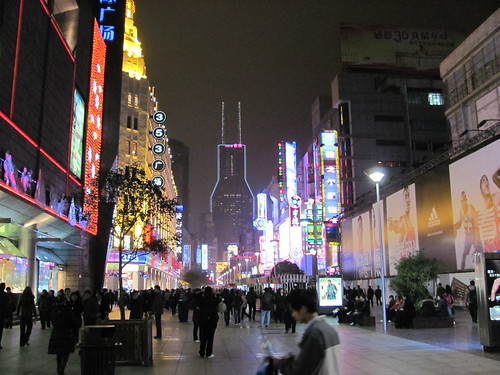
The famous shopping street Nanjing Road in Shanghai, China
On a recent trip to China I discovered that one of the most striking features of Chinese cities, at least to the eye of a Spacing reader, is the difference in the pedestrian environment. In the midst of an upheaval of historic proportions, Chinese cities are caught between a rush to the car driven, bourgeois lifestyle of the west, and the pedestrian and cycling practicalities of its recent past. The Chinese paradigm for urban design in the country’s sprawling new districts seems committed to separating vehicle and pedestrian traffic, both through barriers and grades, in an attempt to preserve the walking culture while accommodating the car. Many interesting design features result.
In Shanghai and Beijing, it is the norm is to have sidewalks cordoned off from the roadway with barriers forcing pedestrian traffic towards overpasses. While pedestrian grade separation is most common at intersections, in Beijing it is also quite common mid-block. Beijing has adopted a car-dependent design of very wide avenues with multiple degrees of separation. Down the centre, several lanes of heavy traffic crawl through congestion while a low speed access road, parking and wide sidewalks occupy the storefront side of a barrier fence. Pedestrian flyovers here almost always have one steep staircase and one very gradual. The overpasses also often provide stairway connections to bus stops, a considerable investment in bus infrastructure.
What this setup gains in easy access for motorists it loses in attractiveness of the pedestrian environment as the pedestrian is distantly removed from the other side of the street. It also must cause obvious difficulties for the disabled. In many ways, it really seems that the human scale of the city has been lost, and it is not uncommon to hear Beijingers complain about the loss of the old city.
But for the most part it is a city of unapologetically wide avenues and broad, open thoroughfares, built on a grand scale rather than a human scale. At least Beijing has found some kind of solution to keep traffic somewhat moving without allowing highways near the city centre.
Shanghai is decidedly less orderly than its northern counterpart and can be divided between its old colonial centre and the bold new financial centre of Pudong, across the Huangpu River. While Beijing is the well-planned capital, Shanghai is a hectic centre for trade and the urban environment reflects a less centrally planned attitude. Elevated highways move through the city, even rubbing up against signature public spaces such as People’s Square. Pedestrian overpasses are slightly less common, often taking the form of an elevated circle around the four points of an intersection, sometimes awkwardly squeezing into the space between the roadway and an elevated highway above (see our previous post about Shanghai’s elevated highways). At some of the larger intersections without pedestrian grade separation, China has the manpower to put crossing guards at intersections, even that seemed travelled almost exclusively by adults.
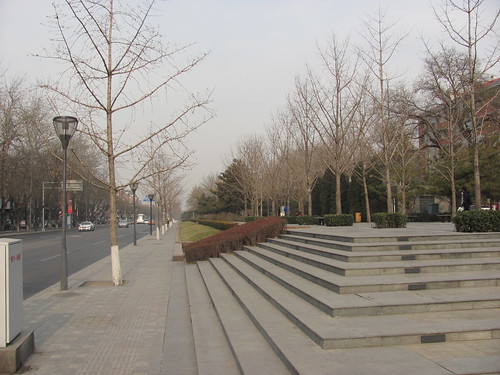
Sidewalk streetscapping and green space along roads
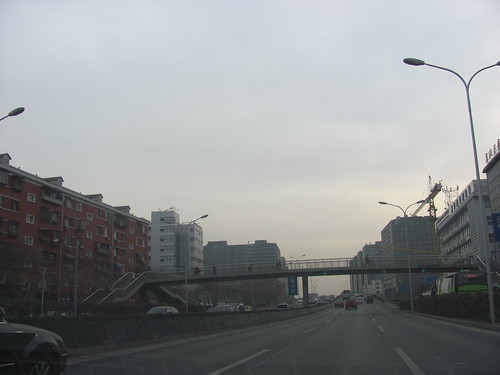
A typical major road in Beijing, with a pedestrian overpass
The city does deserve credit however for its wonderfully wide, and well-landscaped sidewalks. The Shanghai Government proclaims the goal of achieving 40% green space by 2010. At the centre of the plan is creating plazas and attractive areas along the sidewalks of major avenues and roads. In Pudong, this small, detailed greening of the pedestrian environment can best be seen. In the older areas, smaller greening touches can be found (such as the garden topped bike racks, and benches pictured). Also part of this plan is comprehensive improvements along the city’s waterfronts with both the Huangpu and along the subsidiary Suzhou Creek. As part of this, the riverfront is gaining new landscaping and sticking glass pavilions. Along the creek, the city is building a network of parks and new pedestrian crossings.
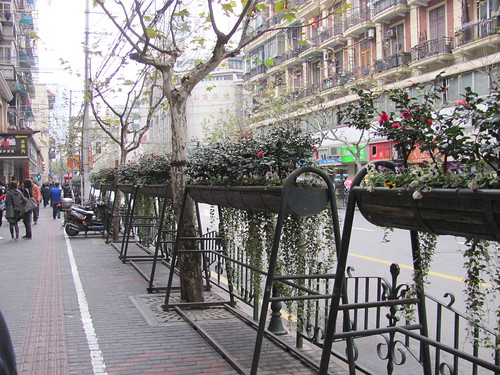
Attractive bike racks in Shanghai
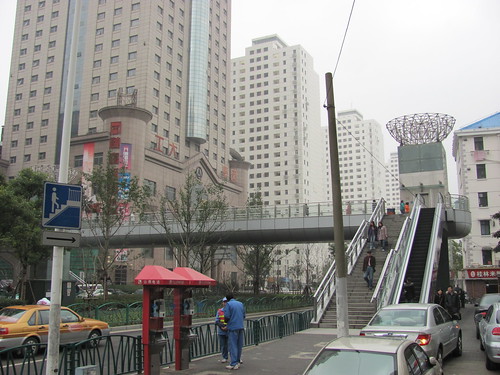
A Shanghai pedestrian crossing showing barriers to the road, crossings were escalators and elevators seemed isolated to upscale commercial areas.
Beijing and Shanghai are both incredible cities that have endured major upheaval and change over the past twenty years. The change has been so great, that both cities have been forced to place great importance on planning, as is witnessed by the fact they both have huge planning exhibition centres in their central squares. What Toronto is obviously different from Chinese cities in that it doesn’t use broad avenues and more importantly that it respects private property rights. But what Toronto can learn can be found both in the details of Chinese urban innovation, and in the importance of comprehensive, broad range thinking.
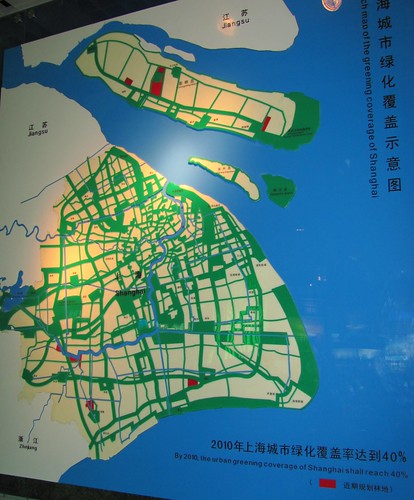
Shanghai’s Government plan to reach 40% green space by this year
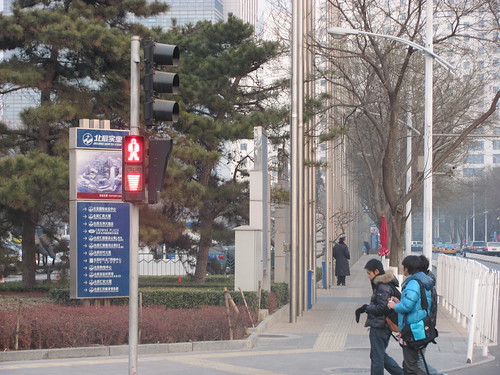
Interesting pedestrian signage near Beijing’s Olympic site. A singal — displayed as horizontal stripes — counts down how long you must wait to cross


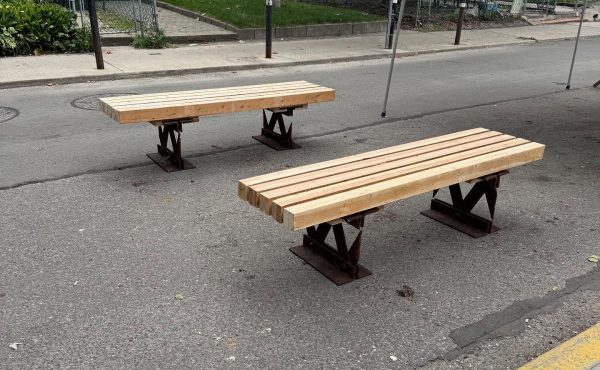

4 comments
Toronto does use some broad avenues like University, Spadina, Jarvis, Lake Shore, St. Clair and a variety of suburban arterials. Perhaps one day Spadina will see its streetcars buried for the addition of more greenspace. Jarvis will be getting the treatment soon.
I was in Beijing a few weeks ago and found that the car-freindly scale reminded me of Mississauga and Scarborough.
An interesting point that you didn’t bring up is that traffic laws in China give priority to vehicles over pedestrians. Pedestrians must yield to all vehicles including cyclists when crossing streets and bike lanes.
That said, there are still lots of great pedestrian-only shopping locales like the Qianmen Market Street
I also found that Shenzhen had a similar scale. Like Beijing, there were some areas of older, more walkable neighborhoods, but it’s still a strong contrast to Shenzhen’s densely populated neighbour, Hong Kong.
the picture of the escalator overpass reminds me a lot of Las Vegas
I’m surprised you didn’t mention or show the many bike lanes that exist on most roads there.
While there, I had the pleasure of riding those bike lanes. They are full width lanes separated from traffic with low barricades. Interestingly bikes share these lanes with scooters, but speeds are low and I could easily blow pass most scooters on my bike.
During rush hour about half the people commuting are either on bikes or scooters, so the bike is not dead in Beijing or Shanghai yet.
How does it compare to riding in Toronto?
Sad to say, I felt safer riding there than here.